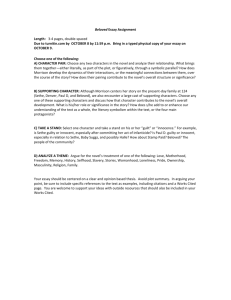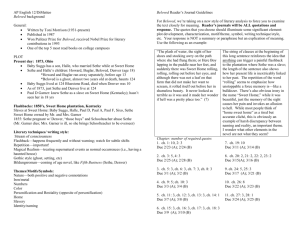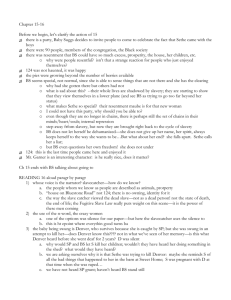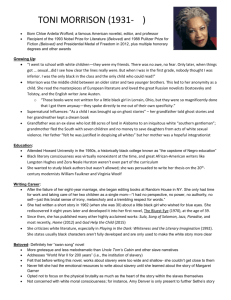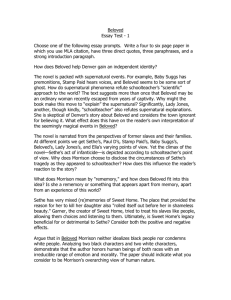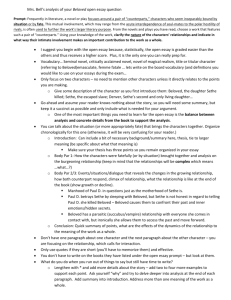Beloved Lecture 4
advertisement
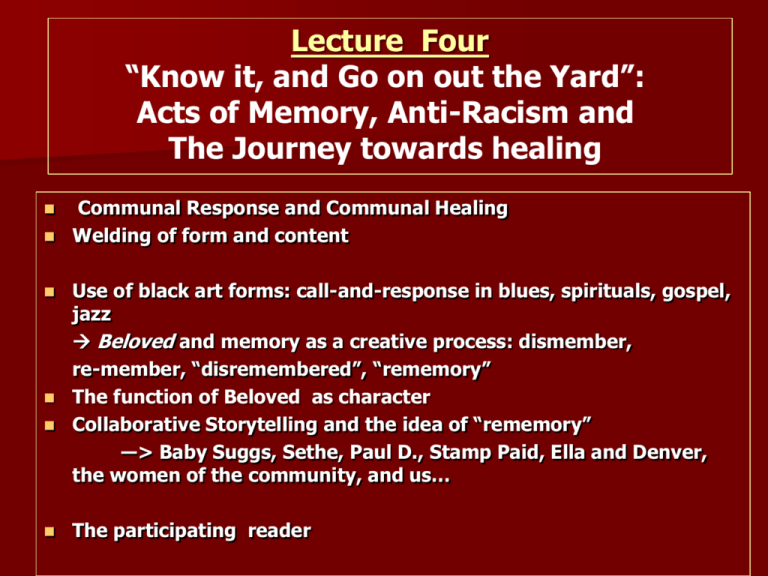
Lecture Four “Know it, and Go on out the Yard”: Acts of Memory, Anti-Racism and The Journey towards healing Communal Response and Communal Healing Welding of form and content Use of black art forms: call-and-response in blues, spirituals, gospel, jazz Beloved and memory as a creative process: dismember, re-member, “disremembered”, “rememory” The function of Beloved as character Collaborative Storytelling and the idea of “rememory” ―> Baby Suggs, Sethe, Paul D., Stamp Paid, Ella and Denver, the women of the community, and us… The participating reader “You mean I never told you nothing about Carolina? About your daddy? You don’t remember nothing about how I come to walk the way I do and about your mother’s feet, not to speak of her back? I never told you all that? Is that why you can’t walk down the steps. My Jesus my.” But you said there was no defense. “There ain’t.” Then what do I do? “Know it, and go on out the yard. Go on.” p. 286-289 [243-44] Freud “Remembering, Repeating, and Working Through (SL) Remembering is conscious Repression is the burial of traumatic and painful memory in the unconscious Repeating is the unconscious acting out of repressed memory Freud: whatever we do not consciously remember we are doomed to repeat - “acting out” What is a ghost? “Foreword”: “Life would be violently disrupted by the chaos of the needy dead” (p. xiii) “Memory Creation and Thought” Deliberate use of “discredited information” Susan Spear’s essay in Body Matters: Feminism, Textuality and Corporeality (RU LIB Level 3: 305.42 BOD) includes this quotation from Jacques Derrida: Ghosts … casualties of history in danger of being forgotten … our duty is to enjoin them, to speak to, with and of them and to mourn them, so as to eventually release ourselves from a history impelled by a cycle of vengeance and retribution Process of healing in 124: Spiteful Loud Quiet Beloved’s function “everybody’s ghost” Repeating implies conjuring up a piece of real life; and for that -- Linden Peach reason it cannot always be harmless A catalyst for memory & unobjectionable. This consideration opens up the whole problem of what real and unreal is so often called deterioration during Return of the repressed treatment – Sigmund Freud Sethe’s “crawling already? baby” A sex slave who escaped An ancestor of the middle passage African traditions & psychoanalytic ideas “rag doll” – renders Sethe and Paul D powerless Re-membering = Collective Story-telling Rememory : memory as a creative process • “Tell me” said Beloved – catalyst for memory/narrative • Sethe: Sethe’s telling and remembering: Nan’s story pp.72-5 28 days - claiming the self p. 111 [95] • Stamp Paid & Paul D pp. 257-277 [218-235] The escape (hush, hush), Joshua & Vashti, Sethe and Beloved • Denver and the modern reader – see Krumholz in Casebook (SL) • Ella p. 301 [256] the cape of sound • The participatory reader: Songs & language, tears & laughter p. 313 [265] Sethe’s acting out The African-American Quilt Photo: Robert E. Williams (1888) • Sethe’s wedding dress • Baby Suggs’s quilt • The crazy dresses and ribbons •The notion of colour • The idea of remembering pieces of the story http://dlg.galileo.usg.edu/hargrett/williams/ Robert E. Williams (d. 1937), an African-American photographer, operated a photography studio, R. Williams and Son, in Augusta, Georgia, from 1888 until around 1908. The African-American Quilt p. 321 [272] Sethe and Paul D. Sixo and the Thirty-mile woman “She is a friend of my mind. She gather me, man, the pieces I am, she gather them and give them back to me in all the right order. It’s good you know when you got a woman who is a friend of your mind” The image of the quilt – piecing together the stories Putting your story next to another’s “me and you, we got more yesterday than anybody, we need some kind of tomorrow” Quilt from: Signs and Symbols: African Images in African-American Quilts, by Maude Southwell Wahlman.
